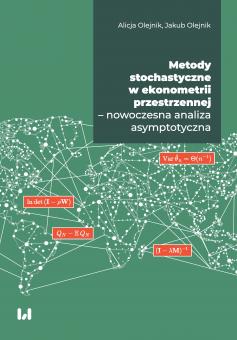-
1002
-
964
-
893
-
795
-
794

Pliki do pobrania
W monografii zostały zaprezentowane najnowsze i w dużej mierze autorskie osiągnięcia z zakresu teorii asymptotycznych stochastycznych modeli ekonometrii przestrzennej. Rezultaty pracy naukowej autorów zostały poprzedzone przeglądem klasycznych, choć przedstawionych w nowoczesnym ujęciu, zagadnień ekonometrii przestrzennej. Ważnym elementem omawianej teorii jest nowe Centralne Twierdzenie Graniczne dla form liniowo-kwadratowych .Pozwala ono na przeprowadzanie formalnych dowodów własności granicznych statystyk testowych autokorelacji przestrzennej oraz estymatorów parametrów modeli ekonometrycznych z zależnościami przestrzennymi.
Anselin L. (1988a), Spatial Econometrics: Methods and Models, Kluwer Academic Publications, Dordrecht.
Anselin L. (1988b), Lagrange multiplier test diagnostics for spatial dependence and spatial heterogeneity, „Geographical Analysis” 20: 1–17.
Anselin L. (1996), The Moran Scatterplot as an ESDA Tool to Assess Local Instability in Spatial Association, [w:] M. Fischer, H. Scholten, D. Unwin (eds.), Spatial Analytical Perspectives on GIS in Environmental and Socio-Economic Sciences, Taylor and Francis, London, s. 111–125.
Anselin L. (2001), Rao’s score test in spatial econometrics, „Journal of Statistical Planning and Inference” 97: 113–139.
Anselin L. (2002), Under the hood: issues in the specification and interpretation of spatial regression models, „Agricultural Economics” 27: 247–267.
Anselin L., Bera A. K. (1998), Spatial Dependence in Linear Regression Models with an Introduction to Spatial Econometrics, [w:] A. Ullah, D. E. A. Giles (eds.), Handbook of Applied Economic Statistics, Marcel Dekker, Inc., New York, s. 237–289.
Anselin L., Rey S. J. (2014), Modern Spatial Econometrics in Practice: A Guide to GeoDa, GeoDaSpace and PySAL, GeoDa Press LLC, Chicago.
Arbia G. (1989), Spatial Data Configuration in Statistical Analysis of Regional Economic and Related Problems, Kluwer Academic Publishers, Boston.
Arbia G. (2006), Spatial Econometrics: Statistical Foundations and Applications to Regional Convergence, Advances in Spatial Science, Springer, Berlin.
Arbia G., Baltagi B. H. (eds.) (2009), Spatial Econometrics. Methods and Applications, Springer, Berlin.
Badinger H., Egger P. (2013), Estimation and testing of higher-order spatial autoregressive panel data error component models, „Journal of Geographical Systems” 15 (4): 453– 489.
Baltagi B. H., Lesage J. P., Pace R. K. (2016), Spatial Econometrics: Qualitative and Limited Dependent Variables, „Advances in Econometrics” 37, Emerald.
Beran J. (1972), Rank spectral processes and tests for serial dependence, „Annals of Mathematical Statistics” 43: 1749–1766.
Besner C. (2002), A Spatial Autoregressive Specification with a Comparable Sales Weighting Scheme, „Journal of Real Estate Research” 24: 193–212.
Bhansali R. J., Giraitis L., Kokoszka P. S. (2007), Convergence of quadratic forms with non-vanishing diagonal, „Statistics and Probability Letters” 77: 726–734.
Billingsley P. (2009), Prawdopodobieństwo i miara, przeł. K. Kizeweter, J. E. Roguski, wyd. 2, Wydawnictwo Naukowe PWN, Warszawa.
Bivand R., Hauke J., Kossowski T. (2013), Computing the Jacobian in Gaussian Spatial Autoregressive Models: An Illustrated Comparison of Available Methods, „Geographical Analysis” 45 (2): 150–179.
Bodson P., Peeters D. (1975), Estimations of the coefficients in a linear regression in the presence of spatial autocorrelation: an application to a Belgian labour–demand function. „Environment and Planning” 7 (4): 455–472.
Born B., Breitung J. (2011), Simple regression‐based tests for spatial dependence, „The Econometrics Journal” 14 (2): 330–342.
Cliff A. D., Ord J. K. (1972), Testing for spatial autocorrelation among regression residuals, „Geographical Analysis” 4: 267–284.
Cliff A. D., Ord J. K. (1973), Spatial Autocorrelation, Pion, London.
Cliff A. D., Ord J. K. (1981), Spatial Processes: Models and Applications, Pion, London.
Corrado L., Fingleton B. (2011), Where is the economics in spatial econometrics?, „Journal of Regional Science” 52 (2): 210–239.
Cramér H., Wold H. (1936), Some Theorems on Distribution Functions, „Journal of the London Mathematical Society” 11 (4): 290–294.
Dacey M. F. (1968), A review on measures of contiguity for two and k–color maps. Technical Report No. 2, „Spatial Diffusion Study”, Department of Geography, Evanston, Northwestern University.
de Jong P. (1987), A central limit theorem for generalized quadratic forms, „Probability Theory and Related Fields” 75: 261–277.
de Jong P., Sprenger C., van Veen F. (1984), On Extreme Values of Moran’s I and Geary’s c, „Geographical Analysis” 16 (1): 17–24.
Deng M. (2008), An anisotropic model for spatial processes, Geographical Analysis 40 (1): 26–51.
Durbin J., Watson G. S. (1950), Testing for serial correlation in least-squares regression I, „Biometrika” 37: 159–178.
Durbin J., Watson G. S. (1951), Testing for serial correlation in least-squares regression II, „Biometrika” 38: 409–428.
Elhorst J. P. (2001), Dynamic models in space and time, „Geographical Analysis” 33 (2): 119–140.
Elhorst J. P., Halleck S. (2013), On spatial econometric models, spillover effects, and W, 53rd Congress of the European Regional Science Association: „Regional Integration: Europe, the Mediterranean and the World Economy”, 27–31 August 2013, Palermo, Italy, http://hdl.handle.net/10419/123888 (dostęp 27.11.2020).
Elhorst J. P., Lacombe D. J., Piras G. (2012), On model specification and parameter space definitions in higher order spatial econometric models, „Regional Science and Urban Economics” 42 (1–2): 211–220.
Feng C., Wang H., Han Y., Xia Y., Tu, X. M. (2014), The Mean Value Theorem and Taylor’s Expansion in Statistics. „The American Statistician” 67: 245–248.
Fingleton B. (1999), Spurious spatial regression: some Monte Carlo results with spatial unit Root and Spatial Co-integration, „Journal of Regional Science” 39: 1–19.
Fisher W. (1971), Econometric estimation with spatial dependence, „Regional and Urban Economics” 1: 19–40.
Florax R. J. G. M., Anselin L. (1995), New Directions in Spatial Econometrics, Springer, Berlin.
Florax R. J. G. M., Anselin L. (2004), Advances in Spatial Econometrics: Methodology, Tools and Applications, Springer, Berlin.
Fujita M., Krugman P., Mori T. (1999a), On the evolution of hierarchical urban systems, „European Economic Review” 43 (2): 209–251.
Fujita M., Krugman P., Venables A. J. (1999b), The spatial economy: Cities, regions and international trade. MIT Press, Cambridge MA.
Getis A., Aldstadt J. (2004), Constructing the Spatial Weights Matrix Using A Local Statistic, „Geographical Analysis” 36: 90–114.
Getis A., Ord J. K. (1992), The analysis of spatial association by distance statistics, „Geographical Analysis” 24: 189–206.
Giraitis L., Taqqu M. (1998), Central limit theorems for quadratic forms with time-domain conditions, „Annals of Probability” 26: 377–398.
Griffith D. A. (2003), Spatial Autocorrelation and Spatial Filtering. Gaining Understanding Through Theory and Scientific Visualization, Springer.
Gupta A., Robinson P. (2015), Inference on higher-order spatial autoregressive models with increasingly many parameters, „Journal of Econometrics” 186: 19–31.
Gupta A., Robinson P. (2018), Pseudo maximum likelihood estimation of spatial autoregressive models with increasing dimension, „Journal of Econometrics” 202: 92–107.
Hájek P., Johanis M. (2014), Smooth analysis in Banach spaces, De Gruyter Series in Nonlinear Analysis and Applications 19, De Gruyter, Berlin.
Hall P., Hyde C. C. (1980), Martingale limit theory and its application, Academic Press, Inc., New York.
Han X., Hsieh C., Lee L. F. (2017), Estimation and model selection of higher-order spatial autoregressive model: An efficient Bayesian approach, „Regional Science and Urban Economics” 63: 97–120.
Hordijk L. (1974), Spatial correlation in the disturbances of a linear interregional model, „Regional Science and Urban Economics” 4 (3): 117–140.
Horn R. A., Johnson C. R. (2013), Matrix Analysis, Cambridge University Press, New York.
Jakubowski J., Sztencel R. (2001), Wstęp do teorii prawdopodobieństwa, SCRIPT, Warszawa.
Kelejian H. H., Piras G. (2014), Estimation of spatial models with endogenous weighting matrices, and an application to a demand model for cigarettes, „Regional Science and Urban Economics” 46: 140–149.
Kelejian H. H., Piras G. (2017), Spatial Econometrics, Academic Press, London.
Kelejian H. H., Prucha I. R. (1998), A Generalized Spatial Two-Stage Least Squares Procedure for Estimating a Spatial Autoregressive Model with Autoregressive Disturbances, „Journal of Real Estate Finance and Economics” 17: 99–121.
Kelejian H. H., Prucha I. R. (2001), On the Asymptotic Distribution of the Moran I Test Statistic with Applications, „Journal of Econometrics” 104: 219–257.
Kelejian H. H., Prucha I. R. (2010), Specification and estimation of spatial autoregressive models with autoregressive and heteroskedastic disturbances, „Journal of Econometrics” 157 (1): 53–67.
Klaassen L. H., Paelinck J. H. P., Wagenaar S. (1979) Spatial Systems, Saxon House, Farnborough.
Kopczewska K. (2007), Ekonometria i statystyka przestrzenna z wykorzystaniem programu R CRAN, CeDeWu, Warszawa.
Kosfeld R., Lauridsen J. (2004), Dynamic spatial modeling of regional convergence processes, „Empirical Economics” 29: 705–722.
Kosfeld R., Lauridsen J. (2006), A test strategy for spurious regression, spatial nonstationarity, and spatial co-integration, „Papers in Regional Science” 85 (3): 363–377.
Kossowski T. (2010), Teoretyczne aspekty modelowania przestrzennego w badaniach regionalnych, „Rozwój Regionalny i Polityka Regionalna” 12: 9–26.
Kossowski T., Hauke J. (2011), The method of computing the Log-Jacobian of the variable transformation for spatial models – test and comments, „Acta Universitatis Lodziensis”. Folia Oeconomica 252: 161–173.
Krugman P. (1991a), Increasing returns and economic geography. „Journal of Political Economy” 99 (3): 483–499.
Krugman P. (1991b), Geography and Trade. MIT Press.
Lauridsen J. (1999), Spatial Co-integration Analysis in Econometric Modelling, „ERSA Conference Papers” ersa99pa181, European Regional Science Association.
Lauridsen J. (2006), Spatial autoregressively distributed lag models: equivalent forms, estimation and an illustrative commuting model, „The Annals of Regional Science” 40: 297–311.
La Vallée Poussin C. de (1915), Sur L’Integrale de Lebesgue, „Transactions of the American Mathematical Society” 16 (4): 435–501.
Lee L. F. (2002), Consistency and efficiency of least-squares estimation for mixed regressive spatial autoregressive models, „Econometric Theory” 18: 252–277.
Lee L. F. (2004), Asymptotic Distributions of Maximum Likelihood Estimators for Spatial Autoregressive Models, „Econometrica” 72: 1899–1925.
Lee L. F., Yu J. (2010), Estimation of spatial autoregressive panel data models with fixed effects, „Journal of Econometrics” 154 (2): 165–168.
Lee L. F., Liu X., Lin X. (2010), Specification and estimation of social interaction models with network structures. „The Econometrics Journal” 13 (2): 145–176.
Lehmann E. L., Casella G. (1998), Theory of Point Estimation, 2nd ed., Springer, New York.
LeSage J. (1999), Spatial Econometrics: The Web Book of Regional Science, Regional Research Institute, West Virginia University, Morgantown.
LeSage J., Pace, R. K. (2009), Introduction to Spatial Econometrics, Statistics: Textbooks and Monographs, Chapman and Hall, Boca Raton, Florida.
Li K. (2017), Fixed-effects dynamic spatial panel data models and impulse response analysis, „Journal of Econometrics” 198 (1): 102–121.
Liu S. F., Yang Z. (2015), Modified QML estimation of spatial autoregressive models with unknown heteroskedasticity and non-normality, „Regional Science and Urban Economics” 52: 50–70.
Łaszkiewicz E. (2016), Ekonometria przestrzenna III. Modele wielopoziomowe – teoria i zastosowania, C.H. Beck, Warszawa.
Meyer P. A. (1966), Probability and potentials, Blaisdell Publishing Co., Waltham, Mass. Moran P. (1950), Notes on Continuous Stochastic Phenomena, „Biometrika” 37: 17–23.
Mynbaev K. T. (2010), Asymptotic distribution of the OLS estimator for a mixed spatial model, „Journal of Multivariate Analysis” 101 (3): 733–748.
Mynbaev K. T. (2011), Short-Memory Linear Processes and Econometric Applications, John Wiley and Sons, Hoboken, NJ.
Mynbaev K. T., Ullah A. (2008), Asymptotic distribution of the OLS estimator for a purely autoregressive spatial model, „Journal of Multivariate Analysis” 99 (2): 245–277.
Nijkamp P., Fischer M. M. (eds.) (2014), Handbook of Regional Science, Springer, Heidelberg.
Olejnik A. (2008), Using the spatial autoregressively distributed lag model in assessing the regional convergence of per-capita income in the EU25, „Papers in Regional Science” 87 (3): 371–384.
Olejnik A. (2013), Wybrane metody testowania modeli regresji przestrzennej, „Przegląd Statystyczny” 60 (3): 381–393.
Olejnik A., Olejnik J. (2019), Increasing returns to scale, productivity and economic growth – a spatial analysis of the contemporary EU economy, „Argumenta Oeconomica” 42 (1): 273–293.
Olejnik J., Olejnik A. (2020), QML estimation with non-summable weight matrices, „Journal of Geographical Systems” 22 (4): 469–495.
Olejnik A., Özyurt S., Olejnik J. (2020), Introducing multi-dimensional weighting factors into spatial econometric models, „Ekonomika Regiona / Economy of Region” [w recenzji].
Ord J. K., Getis A. (1995), Local spatial autocorrelation statistics: distributional issues and an application, „Geographical Analysis” 27 (4): 286–306.
Paelinck J. H. P., Klaassen L. H. (1979), Spatial Econometrics, Saxon House, Farnborough.
Panak [Olejnik] A. (2006), Autokorelacja przestrzenna i kriging – metodologia i wybrane zastosowania, „Prace Naukowe Akademii Ekonomicznej im. Oskara Langego we Wrocławiu”, Taksonomia 13: 483–491.
Pinkse J. (1999), Asymptotic properties of Moran and related tests and testing for spatial correlation in probit models, Department of Economics, University of British Columbia and University College, London.
Pötscher M. B., Prucha I. R. (1997), Dynamic Non-linear Models: Asymptotic Theory, Springer-Verlag, Berlin, Heidelberg.
Pruss A. R. (1998), A bounded N-tuplewise independent and identically distributed counterexample to the CLT, „Probability Theory and Related Fields” 111: 323–332.
Qu X., Lee L. F. (2017), QML estimation of spatial dynamic panel data models with endogenous time varying spatial weights matrices, „Journal of Econometrics” 197: 173–201.
Rao C. R. (1948), Large sample tests of statistical hypotheses concerning several parameters with applications to problems of estimation, „Proceeding of the Cambridge Philosophical Society” 40: 50–57.
Sen A. (1976), Large sample-size distribution of statistics used in testing for spatial correlation, „Geographical Analysis” 9: 175–184.
Shi W., Lee L. F. (2017), Spatial dynamic panel data models with interactive fixed effects, „Journal of Econometrics” 197: 173–201.
Silvey S. D. (1959), The Lagrangian multiplier test, „Annals of Mathematical Statistics” 30: 389–407.
Suchecki B. (red.) (2010), Ekonometria przestrzenna. Metody i modele analizy danych przestrzennych, C.H. Beck, Warszawa.
Suchecki B. (red.) (2012), Ekonometria przestrzenna II. Modele zaawansowane, C.H. Beck, Warszawa.
Szulc E. (2007), Ekonometryczna analiza wielowymiarowych procesów gospodarczych, Wydawnictwo Uniwersytetu Mikołaja Kopernika, Toruń.
Takesaki M. (1979), Theory of operator algebras I, Springer-Verlag, New York.
Tobler W. (1970), A computer movie simulating urban growth in the Detroit region, „Economic Geography Supplement” 46: 234–240.
Whittle P. (1964), On the convergence to normality of quadratic forms of independent variables, „Theory of Probability and Its Applications” 9, 103–108.
Vega S. H., Elhorst J. P. (2015), The SLX model, „Journal of Regional Science” 55 (3): 339–363.
Yu J., de Jong R., Lee L. F. (2008), Quasi-Maximum Likelihood Estimators for Spatial Dynamic Panel Data with Fixed Effects When Both n and T Are Large. „Journal of Econometrics” 146 (1): 118–134.
Zeliaś A., Grabiński T., Ludwiczak B., Malina A. (1991), Ekonometria przestrzenna, PWE, Warszawa.

Utwór dostępny jest na licencji Creative Commons Uznanie autorstwa – Użycie niekomercyjne – Bez utworów zależnych 4.0 Międzynarodowe.
Opublikowane: 6 marca 2025
Monografia „Łódź poprzez wieki. Historia miasta” redagowana przez naukowców z Uniwersytetu Łódzkiego zdobyła już rzeszę oddanych czytelników. Tymczasem w Wydawnictwie UŁ ukazała się kolejna książka o naszym mieście...
Opublikowane: 6 marca 2025
Zapraszamy na spotkanie wokół książki „Niezależni producenci. Studio Filmowe im. Karola Irzykowskiego w latach 1981–2005”.
Opublikowane: 30 stycznia 2025
Zdrowie psychiczne dzieci i młodzieży jest kluczowym tematem w działaniach profilaktycznych skierowanych do młodych ludzi.


